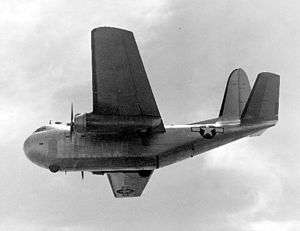
Budd RB Conestoga
The RB-1 Conestoga was a twin-engine, stainless steel cargo aircraft designed for the United States Navy during World War II by the Budd Company of Philadelphia, Pennsylvania. Although it did not see service in a combat theater, it pioneered design innovations in American cargo aircraft, later incorporated in modern military cargo airlifters.
Design and development
World War II created a great demand for military transport aircraft in the United States. Because of initial fears of a shortage of aluminum, the War Department explored the use of other materials for aircraft construction. Budd, the developer of the shotweld technique for welding stainless steel and a manufacturer of stainless steel railroad cars, automobile, bus, and truck bodies, hired an aeronautical engineering staff and worked with the U. S. Navy to develop a new twin-engine transport aircraft constructed primarily of stainless steel. The U.S. Navy accepted the proposal for the new aircraft, and placed an order for 200, to be designated RB-1. The U.S. Army Air Forces (USAAF) followed with an order for 600, designated C-93.
C93
C93 may refer to:
Podcasts:

